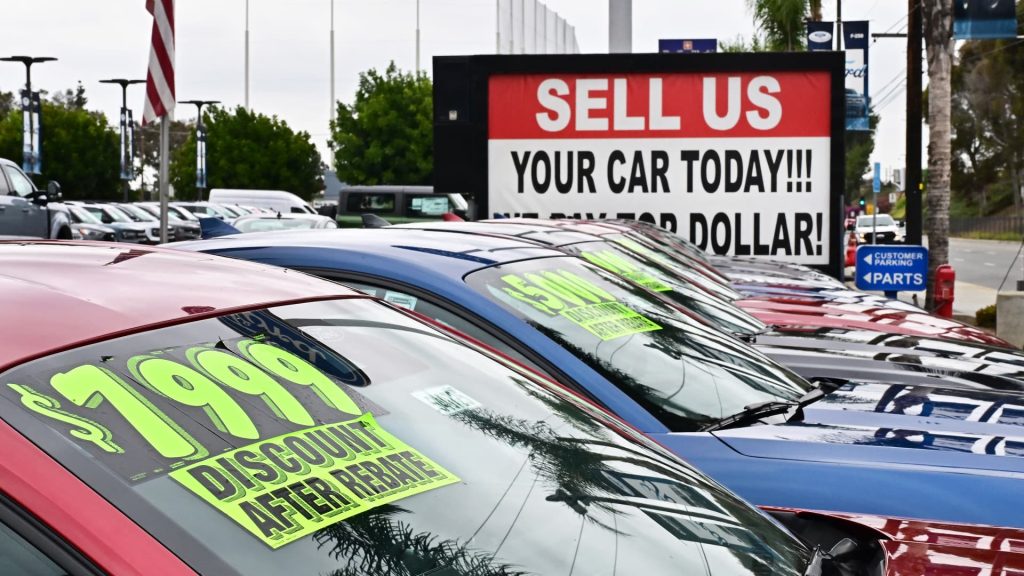The used vehicle market has shown a notable surge in pricing, driven primarily by consumer concerns regarding potential tariff-induced price hikes on new automobiles. Recent data from Cox Automotive’s Manheim Used Vehicle Value Index reveals that prices for used cars have reached their highest point since October 2023. This rising trend indicates shifting dynamics within the automotive sector, providing insights into consumer behavior and market conditions.
| Article Subheadings |
|---|
| 1) Analyzing Last Month’s Surge in Used Vehicle Prices |
| 2) The Impact of Tariffs on Consumer Behavior |
| 3) Understanding Retail vs. Wholesale Price Trends |
| 4) Historical Context of Used Vehicle Pricing |
| 5) Looking Ahead: What This Means for Consumers |
Analyzing Last Month’s Surge in Used Vehicle Prices
In April 2025, the Manheim Used Vehicle Value Index reported a significant increase of 4.9% from the previous year, reaching a level of 208.2. This rise is particularly noteworthy, as it not only reflects a 2.7% increase from the figures recorded in March but also serves as a stark departure from the typical month-to-month fluctuations, which usually hover around 0.2%. This unusual spike can largely be attributed to heightened consumer activity amid fears of inevitable price increases driven by impending auto tariffs. As consumers rushed to secure used vehicles, this palpable urgency created a ripple effect across the pricing structures.
The Impact of Tariffs on Consumer Behavior
The looming 25% tariffs on new imported vehicles and many auto parts have significantly influenced consumer perceptions and purchasing behaviors. Though the tariffs do not directly affect used vehicles, they instigate cascading effects on new car pricing, manufacturing rates, and overall demand within the automotive market. Cox Automotive’s senior director of economic and industry insights, Jeremy Robb, highlighted that although the “spring bounce,” a seasonal increase in vehicle prices, typically subsides after the second week of April, this year represented an extended appreciation period. Robb stated,
“We expected to see strong price appreciation in response to the tariffs, and that’s exactly what came.”
Hence, consumers are not just purchasing vehicles; their apprehensions regarding future pricing are shaping their immediate buying actions.
Understanding Retail vs. Wholesale Price Trends
While retail prices generally align with fluctuations in wholesale rates, the current market presents a divergent scenario. Although wholesale prices have surged, retail prices have not adjusted downward as swiftly in recent years. According to Cox’s reports, retail used vehicle sales decreased by 1.7% in April compared to March, although they showed a promising year-on-year increase of 13%. The average retail listing price for a used vehicle climbed to over $25,000, further emphasizing the disparity when compared to new vehicles, which are averaging nearly $48,000. Such dynamics in pricing reflect broader market trends where consumers are facing higher costs with limited alternatives.
Historical Context of Used Vehicle Pricing
The Manheim index, while significantly elevated compared to historical norms, remains below the record heights observed during the Covid-19 pandemic. Historically, the automotive sector has seen various cycles of pricing, influenced by economic conditions, supply chain fluctuations, and consumer sentiment. The current climate showcases a stabilization trend following several erratic years, with prices beginning to level off since 2024. As the index reflects a gradual normalization post-pandemic, stakeholders continue to watch for signs that prices may stabilize further or face renewed volatility due to economic pressures or regulatory changes.
Looking Ahead: What This Means for Consumers
As the automotive landscape evolves, consumers are urged to consider several factors when making purchasing decisions. The increases in wholesale prices directly affect retail pricing, prompting more consumers to consider used vehicles as viable options in a market characterized by escalating costs. Therefore, understanding market trends, remaining aware of pricing dynamics, and keeping abreast of potential changes in tariffs and their impact is crucial for informed decision-making. The used vehicle market is currently a reflection of both consumer demand and broader economic signals, which are likely to continue influencing buying behaviors in the coming months.
| No. | Key Points |
|---|---|
| 1 | The Manheim Used Vehicle Value Index increased by 4.9% in April 2025. |
| 2 | Consumer fears over new vehicle tariffs are influencing used car purchases. |
| 3 | Retail prices for used cars have not fallen as quickly as wholesale prices in recent years. |
| 4 | The current pricing landscape remains high compared to historical norms but below pandemic peaks. |
| 5 | Understanding market trends is essential for consumers navigating today’s vehicle market. |
Summary
The sharp increase in used vehicle pricing, driven by consumer response to anticipated tariffs, underscores shifting dynamics in the automotive sector. As market behaviors evolve amid economic uncertainties, consumer awareness and adaptability will be vital in navigating these changes. The implications of this surge not only impact individual purchasing decisions but also reflect broader economic patterns, necessitating continued observation from both consumers and industry stakeholders.
Frequently Asked Questions
Question: What factors are contributing to the increase in used vehicle prices?
The increase is largely driven by consumer concerns over new vehicle tariffs, which have led to heightened purchases of used vehicles as consumers aim to avoid potential price hikes.
Question: How do wholesale and retail prices relate to each other?
Generally, retail prices follow trends in wholesale pricing, but current market conditions show that retail prices have not been adjusting downward as quickly as wholesale prices.
Question: What is the historical context of used vehicle pricing?
Historically, used vehicle prices have fluctuated based on various economic factors; the current market, while high compared to pre-pandemic levels, is stabilizing after years of volatility.
